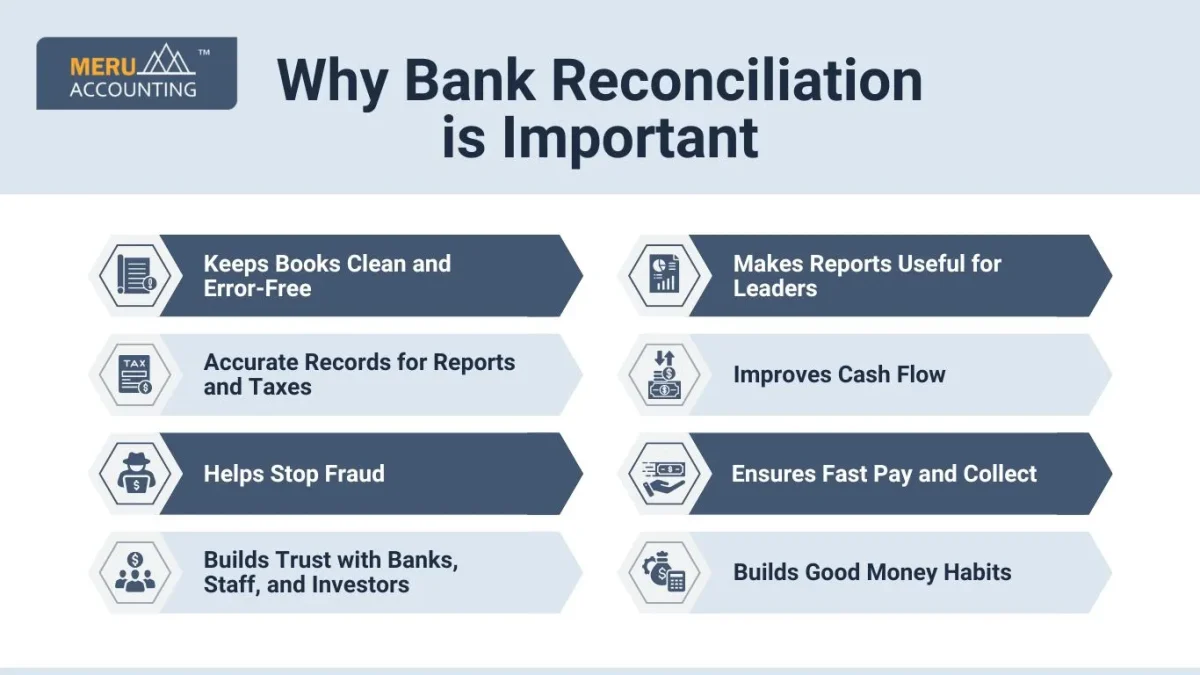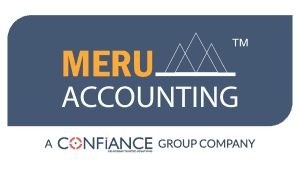Accurate Accounting through Bank Reconciliation: Definition, Example, and Process
Accurate Accounting helps businesses stay clear and safe in money matters. Every business needs records that are fair, clean, and easy to trust. A mistake in money records can lead to late fees, wrong tax filing, or even fraud. Many firms fail not because of low sales, but because they do not keep their books in the right way.
One key way to achieve Accurate Accounting is through bank reconciliation. It is the process that matches company books with bank records. When you reconcile bank statement records, you see the real cash on hand. It also shows errors, missing checks, or extra fees. In this blog, we will learn the meaning, process, example, uses, and tips for smooth bank reconciliation.
What is Bank Reconciliation?
- Bank reconciliation means matching the company records with bank records each time.
- It helps find errors and makes Accurate Accounting strong.
- The aim is to see if both books show the same.
- It is often done to reconcile bank statement entries.
- It shows if the bank and books agree with cash.
- A difference found must be fixed to keep trust.
Why Bank Reconciliation is Important
1. Keeps Books Clean and Error-Free
It makes sure every entry matches the bank record. This cuts down on errors and keeps books neat. Clean books also make checks and reviews much easier.
2. Accurate Records for Reports and Taxes
It ensures numbers are right for all key reports. It also avoids tax issues caused by wrong sums. Good records mean less stress when filing taxes.
3. Helps Stop Fraud
It spots fake, wrong, or repeated entries very fast. Early checks save cash and protect the whole firm. Fraud caught in time keeps trust safe and strong.
4. Builds Trust with Banks, Staff, and Investors
Regular checks prove your money data can be trusted. This builds faith with banks, staff, and new backers. Strong trust makes loans and support much easier too.

5. Makes Reports Useful for Leaders
Clear and checked reports guide leaders in smart plans. It helps them spend, grow, and cut risk with care. Strong reports give leaders a full view of real facts.
6. Improves Cash Flow
It shows the real cash that is on hand. This helps avoid bank fees and smooths cash flow. Good flow keeps the firm safe in hard times.
7. Ensures Fast Pay and Collect
Checks show cash due in, and cash still has not been sent. This stops late pay and keeps ties with vendors strong. On-time cash in and out builds smooth business ties.
8. Builds Good Money Habits
To check bank lines is to build long-term trust. It shapes a habit of clear and fair records. Strong habits keep the firm fit and safe for years.
Key Terms in Bank Reconciliation
- Bank Statement: Record from the bank showing each cash move. Used to reconcile the bank statement with your own ledger.
- Company Ledger: List of money moves made by the business. It is needed to support Accurate Accounting each month.
- Outstanding Checks: Checks sent but not yet bank cleared. They lowered the book cash but not the bank cash yet.
- Deposits in Transit: Money given, but the bank has not yet been added. Seen in books but still not on the bank side.
- Service Charges: The Bank deducts fees that may be missed. Must be added to books for Accurate Accounting.
Process of Bank Reconciliation
Step 1: Collect Records
- Collect the latest bank statement and cash book of the firm.
- Both are required to reconcile bank statement records.
Step 2: Compare Transactions
- Check each line in the bank with the line in the books.
- Tick matched lines to show that Accurate Accounting is kept.
Step 3: Identify Differences
- Look for cash in books but not in the bank.
- Check for bank charges not found in your books.
Step 4: Make Adjustments
- Add bank fees or missed deals to the cash book.
- Change errors so Accurate Accounting is not lost.
Step 5: Finalize
- Both sides must now show the same amount.
- Keep a file of how you reconcile the bank statement.
Example of Bank Reconciliation
- Books show $10,000, bank shows $9,800 cash.
- A check of $300 is still not cleared by the bank.
- The bank took $100 fee, not in the company’s books.
- Adjust books: $10,000 – $100 = $9,900.
- Adjust bank: $9,800 + $300 = $10,100.
- After checks, both balances now show $9,900.
Benefits of Bank Reconciliation
- Error Detection: Helps catch wrong or missed money moves. Ensures Accurate Accounting is clear and safe for reports.
- Fraud Control: Shows fake charges or cash theft fast. Reconciling bank statements helps guard firm assets.
- Cash Flow Clarity: Real cash is seen with no guesswork. Good cash data supports daily and monthly plans.
- Easy Audit: Makes tax audits smooth and less tense. Proof of Accurate Accounting is seen in clear reports.
- Peace of Mind: Owners feel safe with true cash information. Reconciling bank statements steps lower stress and risk.
Challenges in Bank Reconciliation
- Some records or slips may not be stored with care.
- This can harm Accurate Accounting and trust in books.
- Bank delays can cause cash not to show up on time.
- Such gaps make it hard to reconcile the bank statement.
- A large number of daily deals slows down the match.
- Errors increase when cash flow is high in size.
- Wrong entry by staff can mislead the firm’s books.
- A fix is needed to keep Accurate Accounting.
Tips for Smooth Bank Reconciliation
- Reconcile the bank statement each month for the best result.
- This avoids large gaps in books and bankside.
- Use software tools that match items fast and safely.
- Tech helps Accurate Accounting and reduces staff stress.
- Keep every invoice and slip in safe order.
- This makes the reconciliation of the bank statement task smooth.
- Train staff to post each cash move without delay.
- Good staff work supports Accurate Accounting at all times.
- Review each adjustment before you close the month.
- This ensures trust when you reconcile the bank statement.
Accurate Accounting and Bank Reconciliation
- Accurate Accounting needs clear records and fair books.
- Bank reconciliation gives this by matching both sides.
- Firms that fail to reconcile bank statements face risk.
- Their reports may mislead and harm their growth.
- A small error can harm cash and trust quickly.
- Reconciliation keeps both safe and up to date.
Tools for Bank Reconciliation
- Manual Method: Match records with a pen or a sheet by hand. Still works, but slows down Accurate Accounting for big firms.
- Accounting Software: Tools like QuickBooks match lines fast. They help reconcile bank statements and reduce errors.
- Bank Feeds: Data comes directly from the bank each day. They give real-time cash for Accurate Accounting.
- AI Tools: Smart bots spot strange moves in cash. These tools help reconcile bank statements more safely.
Role in Small Businesses
- Small firms need Accurate Accounting for tax and growth.
- Bank reconciliation helps them see real cash fast.
- It avoids overdraft or bounced checks at the bank.
- Owners feel safe when they reconcile the bank statement.
- It makes it easy to get a loan from a bank.
- Clean records are proof of trust and good care.
Common Errors Found in Reconciliation
- Wrong cash posted due to a slip or a wrong hand.
- A fix is needed for Accurate Accounting to stay true.
- Bank fees may be missed in the firm’s cash book.
- This is seen when you reconcile the bank statement.
- Some checks are sent but have not yet been bank cleared.
- They show a gap in both records for that time.
- Double entry of the same cash move in the ledger.
- Such errors harm Accurate Accounting until solved.
How Often to Reconcile Bank Statements
- Most firms do bank reconciliation once each month.
- This helps keep Accurate Accounting safe and clear.
- Big firms with large cash flow may do weekly.
- It avoids large gaps and builds trust in data.
- Small firms may do it monthly or every quarter.
- The best way is to reconcile bank statement often.
Bank Reconciliation and Fraud Prevention
- Helps find fake checks or bad bank moves fast.
- This makes Accurate Accounting secure for all users.
- Shows cash taken out without approval or proof.
- Helps reconcile the bank statement to stop such risks.
- It spots staff theft by reviewing cash lines.
- It makes sure cash is used with care.
Bank Reconciliation in Accounting Software
- Software can auto-match book and bank lines quickly.
- This helps Accurate Accounting in real time each day.
- Alerts show if one cash line does not match.
- You can reconcile bank statements faster with tools.
- It cuts down errors seen in manual work.
- It also saves time and gives a sense of trust.
Accurate Accounting is not only about adding numbers. It is about trust, proof, and safe business steps. Bank reconciliation is a key part of this process. When you reconcile bank statement records, you make sure your cash records match the real cash in the bank. This builds safety, trust, and clear cash flow.
At Meru Accounting, we know the value of clean records. We help clients with bank reconciliation, cash reports, and strong Accurate Accounting. Our team uses the best tools to reconcile bank statement lines with care. We focus on trust, speed, and error-free results. Partner with Meru Accounting, and you can feel safe that your books are always clear, fair, and ready for growth.
FAQs
Q1: What is bank reconciliation in simple words?
It means matching company cash books with bank statement records.
Q2: Why is it needed for Accurate Accounting?
It helps find errors, fraud, and missed cash moves.
Q3: How often should you reconcile bank statement entries?
Most firms do it monthly, some do it weekly.
Q4: Can bank reconciliation be done by hand?
Yes, but software makes it faster and more safe.
Q5: What errors can reconciliation find?
It finds missed fees, wrong posts, and bank mistakes.
Q6: Does it stop fraud in a business?
Yes, it helps stop theft and fake cash moves.
Q7: What is the main goal of reconciliation?
To keep Accurate Accounting and build cash trust.








